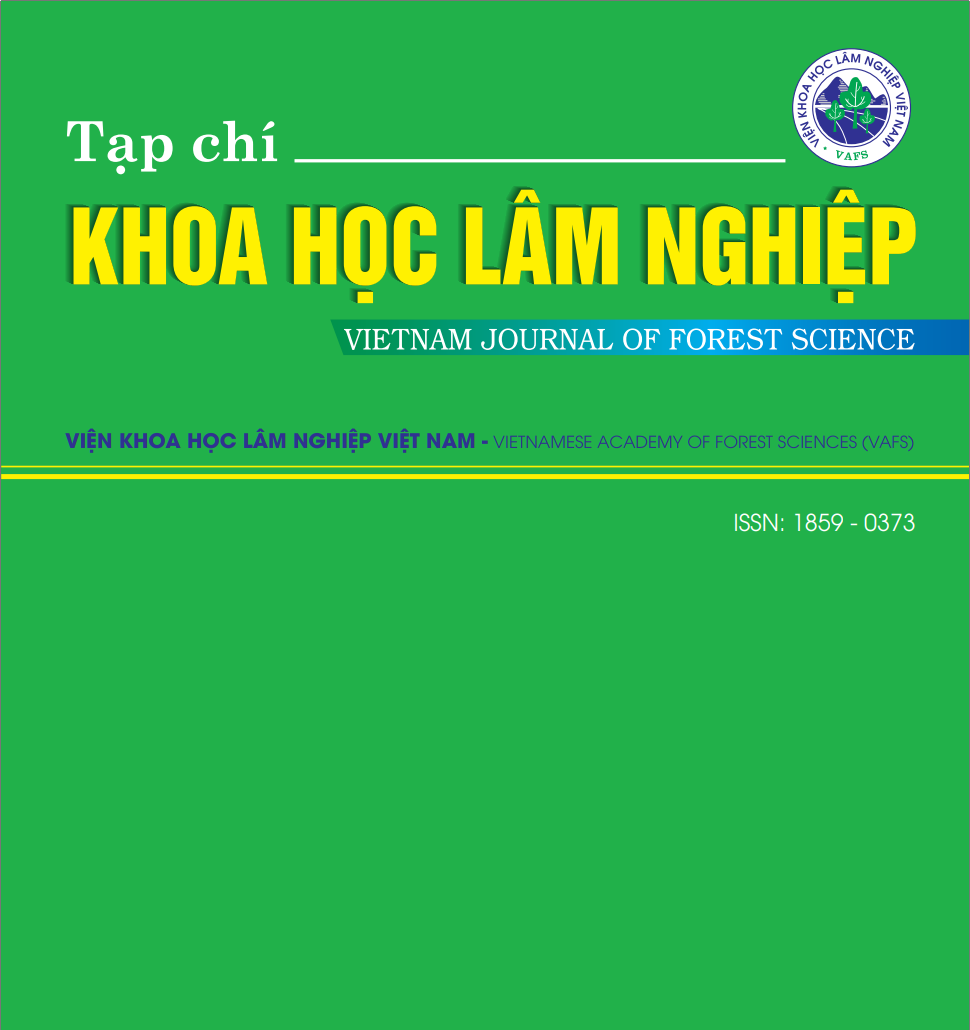THE EFFECT OF TEMPERATURE, RELATIVE HUMIDITY, WOOD MOISTURE CONTENT ON GROWTH OF MOLD, STAIN FUNGI SPECIES
Keywords:
Growth, substrate, temperature, relative humidity, wood moisture contentAbstract
Aspergillus niger Ni, Penicillium citrinum GSĐ 4.4, Trichoderma atroviride GT 22.2, Aureobasidium pullulans Apu 01, Lasiodiplodia theobromae GB 5.3 are main species that harm to freshly wood. Depending on the conditions of temperature, environmental humidity, and humidity of different wood materials, the growth of fungi is also different. In order to control these species, the variation of temperature, relative humidity and wood moisture content was studied. Our studies have proved that Penicillium citrinum GSĐ 4.4, Aureobasidium pullulans Apu 01 và Trichoderma atroviride GT 22.2 grows best at 30 ± 2oC, Aspergillus niger Ni và Lasiodiplodia theobromae GB 5.3 grows best at 35 ± 2oC. All five fungi species have good growth at the humidity 65 - 95%RH. Hight wood moisture content (90%) is suitable for mold, stain fungi. Low wood moisture content (15%) make the mold, stain fungi species have poor growth.
References
1. Bùi Thị Thủy, 2022. Báo cáo thành phần loài nấm mốc, nấm biến màu gây hại gỗ tròn, gỗ xẻ, ván bóc còn tươi từ gỗ rừng trồng. Báo cáo chuyên đề thuộc đề tài: Nghiên cứu công nghệ bảo quản và chế biến đồ gỗ xuất khẩu từ nguyên liệu gỗ rừng trồng (Chiêu liêu nước, Sao đen, Dầu rái). Đề tài trọng điểm cấp Bộ Nông nghiệp và Phát triển nông thôn.
2. De Ligne L., G.V.-D. de Ulzurrun, J.M. Baetens, J. Van den Bulcke, J. Van Acker, B. De Baets, 2019. Analysis of spatio-temporal fungal growth dynamics under different environmental conditions, IMA fungus, 10(1), 1-13.
Hendey N. I., 1996. How fungi attack materials. Science Journal. Vol. 2. N0 1 43-49.
4. Pasanen A.L., 1991. P. Kalliokoski, P. Pasanen, M. Jantunen, A. Nevalainen, Laboratory studies on the relationship between fungal growth and atmospheric temperature and humidity. Environment International, 17(4), 225-228.
5. Pitt, J.I. & Hocking, A.D., 1997. Fungi and food spoilage. (2nd ed.) Blackie Academic & Professional, London, 203-417.
6. Snow D., 1949. The germination of mould spores at controlled humidities, Annals of Applied Biology, 36(1), 1-13.
7. Thạch Thị Ngọc Yến, Nguyễn Văn Phong, 2016. Nghiên cứu tác nhân gây bệnh thối quả chôm chôm (Nephelium lappaceum L.) sau thu hoạch ở Đồng bằng sông Cửu Long. Tạp chí KH Nông nghiệp Việt Nam, tập 14, số 12: 1868-1873.
8. Trần Ngọc Lân, Nguyễn Thị Thu, Nguyễn Thị Thanh, Hồ Thị Nhung, Nguyễn Thị Thúy, Đào Thị Thanh Xuân, Thái Thị Ngọc Lam, Phan Thị Giang, 2013. Miêu tả loài Trichoderma atroviride Karst. ứng dụng trong phòng trừ sinh học nấm mốc Aspergillus flavus hại nông sản. Hội nghị khoa học toàn quốc về sinh thái và tài nguyên sinh vật lần thứ 5.
9. Watkins R.D., 2003. Mould in optical instruments, Community eye health, 16 (46), 28.









